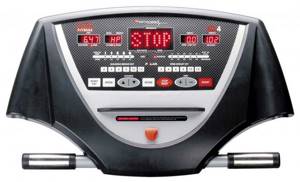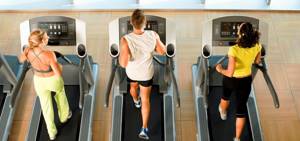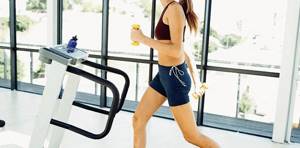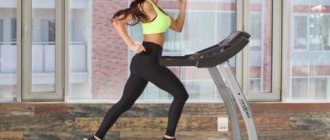Hello, dear reader! In this article I will tell you how to properly exercise on a treadmill.
Let me clarify right away that here I am proceeding from the assumption that previously you either did not engage in any physical education at all or did it occasionally, or that was a long time ago, 10-20 years ago, as is often the case. However, even if you are already experienced and have been training for a long time, the proposed scheme will give you a clear structure of training on any cardio machine. You can easily adapt it to your level of training by replacing load levels with higher ones, and walking with running.
Security measures
Walking is an ideal way to get started. Walking can be done even with serious contraindications to sports. I recommend reading this post about walking.
Please note that this does not relieve you of the need to talk to your doctor before starting classes. Things like spinal curvature, flat feet, problem joints, infectious diseases, etc. must be taken into account and treated with special methods. Fitness is not medicine, remember that. The best path to health and slimness is a reasonable combination of medical care and fitness. Why abandon the achievements of modern medicine? They greatly simplify life, eliminating current diseases and their possible delayed consequences.
About the treadmill
Modern cardio equipment amazes with its variety and technology. But the basis of classes on them is always built on ordinary physics, taking into account the laws of the physiology of the body. Here we always deal with concepts such as work, intensity, power, heart rate, duration, etc. That is, with specifically measurable concepts.
A treadmill in English is called a treadmill, which literally means “device for walking.” We call it a treadmill. Actually, this is a walking machine that you can run on.
The main components of the treadmill are the control panel and the running belt along which you need to walk.
Treadmill
The remote control may look very complicated, but in reality its main functions are:
- Change the driving speed using two keys (increase and decrease).
- Changing the angle of the running tape using two keys (up and down).
- Start and stop buttons.
The remote control panel may contain a lot of other buttons (fan, activation of special built-in programs, load monitor, information about the distance traveled, heart rate, inclination angle, etc.). And, frankly, no serious coach uses most of these options.

Treadmill remote control
If you work out in a gym, ask a trainer to teach you how to use the basic functions of the machine (speed, incline, on and off). If you train at home, carefully study the instructions for the simulator.
And please treat the “calorie burnt counter”, the amount of fat burned, the percentage of body fat with a certain amount of humor. This is one of the most useless functions and has almost no relation to reality.
What are handrails used on a treadmill?
A modern treadmill has handrails on either side of the control panel. Handrails may have sensors (these are metal parts of the handrail that you need to place your palms on) that allow you to monitor your heart rate and control buttons. To determine your pulse using such a sensor, you need to hold it with your hands for several minutes (not seconds!).
Handrails are convenient if you suddenly lose your balance. You can immediately grab them and adjust your body position.

Treadmill handrails
However, you should not walk constantly holding onto the handrails and, especially, leaning on them, shifting part of your weight onto them. This removes a significant part of the much-needed load from you and leads to a decrease in the effectiveness of the workout. Therefore, do not “hang” on the handrails, but “carry” yourself. It is important.
There's nothing funnier than watching a person hanging with all his weight on the handrails of a treadmill, but trying hard to burn as many calories as possible by racking up the miles...
How to run correctly?
If you are interested in how to start running on a treadmill correctly, the first thing you need to do is learn the rules.
- Any workout always begins with a warm-up - do a small set of exercises to warm up your joints and muscles. Bends, swings, squats, stretching, circular movements are suitable;
- According to the treadmill running technique, start the exercise correctly with walking, and after a couple of minutes switch to jogging;
- You cannot immediately put a high load on the body, so it is important to monitor your heart rate so that they are always in the normal zone (120-130 beats/min);
- Properly structured workouts are always based on increasing the load. Try to increase your goal by 5-7% every week;
- Many people are interested in how long to run on a treadmill, and we will answer that the minimum interval should be at least 30 minutes. It doesn’t make sense to do less, it’s better to spend this time on other exercise machines. By the way, if you want to know how long you should run on a treadmill to lose weight, be prepared to spend at least 50 minutes on the treadmill. The fact is that only 40-45 minutes after the start of a sports activity, the body begins to draw energy from accumulated fat. During the previous period, it works on glycogen, carefully accumulated by the liver.
- To increase the effectiveness of the exercise, it would be correct to alternate the running pace from fast to slow, or set the running surface to a slight upward slope. If you are wondering how fast to run on a treadmill, we would advise you to first listen to your feelings. It is recommended to run no more than 300 m at maximum acceleration, then switch to jogging. The optimal running speed on a treadmill is 6-8 km/h;
- They finish the workout with a cool-down - do breathing exercises, stretch their ligaments, and stretch.
Walking on a treadmill. Safety regulations.
Be sure to hold onto the handrail before turning on the treadmill. Once you start walking, make sure you are walking steadily and balanced, then release the handrail. If you do not feel stability and balance, hold on to the handrail, but do not “hang” on it.
If you have long hair, you should collect and style it during training. This will protect you in case of a fall.
Smoothly start moving on the track and finish it smoothly using the appropriate buttons.
If you experience dizziness, nausea, chest pain or other unpleasant symptoms while walking, you should stop walking and consult a doctor.
Don't be tempted to immediately use the "super-fancy", "super-interval" and other built-in programs, even if your trainer recommends them. You are a beginner and this is not for you right now. By avoiding basic exercise in the form of walking, you are putting your health at great risk. This risk is not justified, believe me. In addition, in just 2-4 weeks your heart will become stronger, and you will be able to train more intensely, using more serious training methods. Haste will ruin everything.
Don't exercise in a draft. There is nothing more offensive than getting pinched in the neck or lower back due to local cooling of the neck or back (a T-shirt wet from sweat and a draft).
Are you trying to lose weight?
Experts from around the world agree that it is walking that will help you (long, first leisurely (warm-up), then intense and, finally, “cool-down”). However, it is generally accepted that not eating for an hour and a half after walking on a treadmill and drinking enough water is the option that is most suitable for people trying to get rid of extra pounds.
Are you tired of blood pressure, heart rhythm disturbances?
It’s unlikely that you should immediately accept your friends’ offer to “run in the park in the morning.” Running develops your heart rate to 170-180 beats per minute. This is the key disadvantage of intense exercise: it can be harmful for a hypertensive person or a person with documented heart rhythm disturbances.
Are you a non-professional athlete?
Consequently, there is no talk of a muscle corset, as well as super-elastic ligaments, “hardened” joints and “rope vessels” through which a trained heart pumps blood. It's too early to run! It’s worth walking around to prepare your body for running.
Are you a diabetic, a smoker, or is your body mass index greater than 30?
Go. Just walk, not run on a treadmill. And you will never regret that you gave your body a feasible load.
Fast walking on a treadmill for weight loss!

Is this a myth or reality? Perhaps fast running is best for “fast” weight loss? No. The truth is that taking a step on a treadmill helps you lose weight no worse (and most importantly, safer) than a desperate attempt to sweat out 15-20 minutes of running (super-intensive) training. And that's why.
Fast walking on a treadmill
Walking on a treadmill specifically for the purpose of “losing weight!” should take place in the morning. And that's why. Catabolic processes predominate in the human body in the morning. In order to maintain a walking pace, the body, even in such a “gentle” (non-running) mode, requires a power source. And this source of nutrition becomes the fat located under the skin, which goes “into the furnace” in deeds, and not in words, if you train on an empty stomach.
Treadmill walking program
Only beginners may think that a treadmill walking program is a “somewhat depleted” training option. In fact, there are a great many variations of walking on a treadmill, and this deserves a separate paragraph of our article.
Interval training - we will specifically focus on walking on a treadmill, the benefits of which will be maximum. And the efficiency will be able to please in the shortest possible time both those who want to normalize their heart rate by lowering blood pressure, and those who gravitate toward basic weight loss.
What is "interval"? This is a continuous change of movement variations throughout the entire workout (walking fast, slow, downhill, without a slope). The human body is unique. He can adapt to anything. And this is where they don’t allow him to adapt to anything.
You should start with a “sturtle” walk at a speed of 4 km/h, and even if you want to “rush,” you need to maintain this slow pace for 10 minutes of walking without bending over. The next phase of training is key. It lasts about 30 minutes. And it is important to increase the inclination angle by 2 degrees every 5 minutes, gradually increasing the load. What about speed? Let it also be increased by only 1-2 km, to 5-6 km/h.
Simple calculations allow us to establish that at the highest point of walking on a treadmill, your inclination angle will have to be as much as 12 degrees. This is a lot. Having reached the peak, reduce the load by 2 degrees every one and a half to two minutes during the so-called “cool-down” phase. As a result, you must again “march” along a completely horizontal surface.
So, 50-60 minutes of interval training. After walking on the treadmill, to achieve maximum effect, do not eat for 1-1.5 hours.
"Mountain training" The difference between this training option is that after the first “warm-up” stage, which lasts about 10 minutes at a speed of 4-5 km/h, you immediately set a large inclination angle of 8-10 degrees. And you walk at a speed of 6 km/h for thirty minutes.
With such an inclination of the running belt, walking will never seem easy to you. The body receives sufficient stress to normalize weight, heart rate, blood pressure, but at the same time the pulse does not break through extreme levels, the risk of a heart attack, overtraining, muscle pain, and other negative consequences is minimal.
The training format will be appreciated not only by men, but also by women. Walking uphill strengthens and tightens the buttocks, creating relief in the calf muscles.
The “mountain training” ends with a cool-down phase, during which the incline is reduced to zero, and the movement continues at a “reset” speed of 4 km/h for the next 10 minutes.
Walking with weights . Over time, when it seems that walking has become “too easy,” you can, of course, run. But that would be a mistake. Even if your ultimate goal is to run and compete in half marathons and marathons, don't rush into running mode. It will be great to add weights.

You can pick up small dumbbells (0.5 kg or 1 kg), or you can attach special weights to your ankles and wrists, which will make walking more difficult, but at the same time increase the effectiveness of the workout.
This format (walking with weights) is suitable for those who have already mastered the treadmill or want to accelerate the achievement of results. Start with 0.5 kg weights. Increase, if you can, by half a kilogram every week.
Do not neglect three-phase training: first warm-up (10 minutes at a speed of 4 km/h), then the main mode - half an hour at 6 km/h (at first without an incline, then you can complicate the process by setting an incline of 4-6 degrees), and in the final - cool-down phase. Calm walking with weights on a horizontal surface.
What happens to the body after walking on a treadmill?
In order to answer this question, it is necessary to understand the specifics of the chosen training. What happens after walking on treadmills?
Already during the workout, fat burning processes are launched. As already noted, you lose weight most effectively if your heart rate is increased to 120-130 beats per minute. Attention! It is in the walking mode that visceral (subcutaneous) fat does not return (of course, if you do not start eating bread rolls at night).

Blood circulation improves. Walking (as opposed to an unreasonably abrupt “running start,” which in itself is stressful for the body) makes its health-improving contribution to the state of the cardiovascular system. Blood pressure is lower. And the pulse becomes lower after walking on a treadmill for 2-3 months. Extrasystoles and heart rhythm disturbances disappear.
You do not feel tired, but a surge of efficiency. Congratulations! You have managed to develop your body's endurance. This means that it’s not only about excellent physical fitness, but also about increasing business and production performance, which walking on a treadmill gives.











